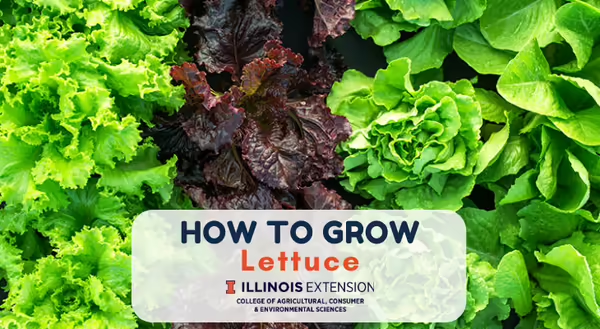
Did you hear about the tomato and lettuce? Well, the lettuce was a-head and the tomato was trying to ketchup.
I haven’t seen any lettuce and tomatoes racing lately; however, being a fairly hardy, cool-season crop, lettuce tends to thrive more than tomatoes (a warm-season crop) in temperatures we are currently experiencing, between 60°F to 70°F.
Let's Talk Lettuce
Lettuce is an annual crop in the Asteraceae family. Often, we think of lettuce as the leafy green in our salad, but it can also be grown for its seed and stem.
- Varieties: There are many options to choose from including loose leaf, crisphead, butterhead, romaine, and stem (also known as asparagus lettuce).
- Planting (spring): Lettuce can be planted once soil temperatures are above 40°F but tend to germinate best at 55°F to 65°F. It is best to plant lettuce at least a month before summer to avoid the heat. Lettuce does not withstand heat well.
- Planting (fall): For fall production, lettuce can be planted in late summer to be harvested in the fall. Some varieties of lettuce (mainly loose-leaf) are more tolerant to summer heat.
Planting Lettuce: Direct seed or transplant?
For an ongoing supply of lettuce greens, do successive plantings 10 to 14 days apart. Frequent watering is very important for both seed germination and the establishment of seedlings.
Direct seed or transplant: Leaf, romaine, and butterhead lettuce can be direct-seeded or transplanted.
- Start with new seed. Lettuce seeds do not keep well season to season resulting in poor germination.
- Direct plant seeds ¼ to ½ inch deep with rows 12 to 18 inches apart. It is typically best to over plant lettuce seeds at 10 seeds per foot and thin seedlings to 4 inches apart.
Transplant: Head lettuce is more commonly transplanted.
- When starting transplants indoors, remember to acclimate the seedlings to the conditions outside before transplanting them outside; this is called hardening off.
- Plant leaf lettuce transplants 3 to 4 inches apart and head lettuce 10 to 12 inches apart while maintaining 12 to 18-inch row spacing.
Lettuce Care
Water: The key to lettuce production is a frequent supply of water, especially during dry times. It is important not to overwater which can lead to disease and soft growth. Mulching with a layer of straw can help retain soil moisture. Another method would a drip irrigation system.
Pests and Disease: Generally, lettuce is disease and pest-free, but occasionally, aphids, slugs, and cutworms can be an issue. Foliage rots can be an issue in hot or wet seasons; this is best controlled by providing adequate soil drainage. It is always a good idea to scout for diseases and pests to be able to control them before they become an issue.
Harvest and Storage: Once leaf lettuce leaves are developed, the lettuce can be cut off at the soil line. Cutting every other plant allows the remaining plants more space to grow. At 50 to 60 days, leaf lettuce has reached its maximum size. Butterhead varieties reach their maximum capacity around 60 to 70 days. It is best to harvest lettuce earlier rather than later as it can become bitter and tough. After harvesting lettuce, it is important to wash and store it in the refrigerator.
BLT Pasta Salad
When it comes to eating lettuce, it can be enjoyed in a simple salad or added to a recipe for a crisp, fresh taste. This is a tasty new recipe we recently tried and found delightful.
Dressing:
- ¾ cup mayo (I prefer to use olive oil mayo to cut some fat & calories)
- ¼ cup sour cream
- 1 Tablespoon milk
- ½ teaspoon pepper
- 1/4 teaspoon salt
- ¼ teaspoon garlic powder
- ¼ teaspoon crushed red pepper, optional
Salad:
- 8 oz spiral pasta
- 3-4 cups chopped romaine lettuce (or 10-oz package pre-cut romaine lettuce)
- 1 pint grape tomatoes, halved
- 1 ½ cup shredded cheddar cheese
- 1 ½ cup bacon bits or pieces (about 6 oz)
INSTRUCTIONS
- Prepare the dressing by stirring together mayo, sour cream, milk, pepper, salt, garlic powder, and crushed red pepper (if using) until smooth and well-combined. Set aside.
- Prepare pasta according to package instructions. When finished cooking, drain well and transfer to a large salad bowl.
- Add chopped lettuce, grape tomatoes, cheddar cheese, bacon bits/pieces, and your prepared dressing.
- Toss/stir very well, until ingredients are well-combined.
- Enjoy!
Subscribe to Good Growing!
Want to get notified when new Good Growing posts are available? SIGN ME UP!